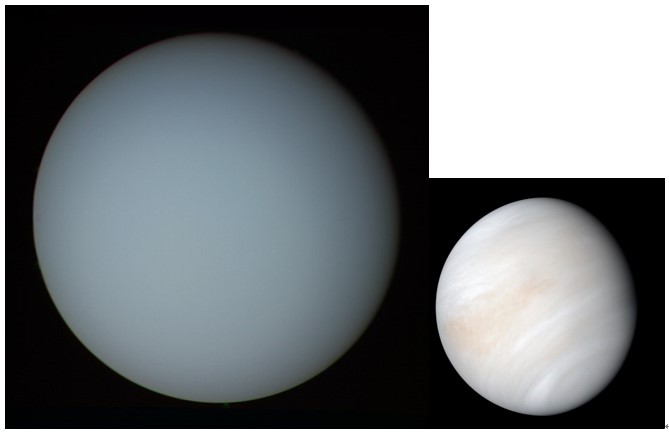
I learned this today. Venus and Uranus spin in the opposite directions to the other planets possibly because Venus flipped over and Uranus was hit by another planet.
Our sun rotates anticlockwise, and it takes about 27 days to complete one rotation. Because the sun rotates anticlockwise, all of the planets in our solar system should rotate anticlockwise. This would be because of the way they form.
The early sun would have had masses of gas and dust whirling around it in a giant ring, called a solar nebula. This giant ring would have rotated anticlockwise because it was being pulled around by the sun’s gravity. As the gas and dust rings started to accrete into planets, they carried on rotating anticlockwise because of the energy imparted to them by the sun’s gravity. In a vacuum, an object in motion will continue to move in that direction unless another force acts upon it.
That is why the Earth rotates anticlockwise and the sun rises in the east and sets in the west. That is the way it is on 6 of the 8 planets, but Venus and Uranus rotate in the opposite direction. This is called retrograde rotation. Why? Well, there is no definitive answer, but here are the main theories.
Venus first. Venus rotates clockwise and it does it extremely slowly. Earth rotates at 1,674 km/h while Venus rotates at 6.52 km/h. If you could run on the surface of Venus, you could keep the sun above you. Venus rotates so slowly that it takes 243 days to make one complete rotation.
One theory for Venus’s retrograde rotation is that it was struck by a large asteroid or a planetoid billions of years ago that caused it to reverse direction. The trouble with this theory is the size of Venus itself. Any planetoid large enough to reverse the rotation of Venus would have to be so high that it would have destroyed the planet.
This theory is making a slight comeback in recent years. Some experts contend that two planetoids collided and formed one planet. They suggest that this is why there is no water on Venus. The impact was so large that it blasted all of the water off the planet. Other experts suggest that evaporation removed the water. The only way to do this would be to do a mineralogical survey of the planet, but this is not likely to happen any time soon. NASA is planning to send a robot to Venus before the end of the 2020s.
A second theory is that Venus is still spinning in an anticlockwise direction, it is just doing it upside down. This would have been caused by two things. Firstly, the core and the mantle of the planet rotate at slightly different speeds. This causes a lot of friction. Secondly, Venus has an incredibly thick atmosphere that is actually rotating much faster than the planet itself. The atmosphere rotates once every four days, as opposed to the 243 days for the planet surface. Venus is very close to the sun, and the enormous gravitational pull causes atmospheric tides. The sun heats up one side of the atmosphere and the warm part of the atmosphere is pulled away from the cold part. This is called tidal torque. This tidal torque combined with the speed of the spinning atmosphere and the friction of the mantle and the core of the planet could have acted together to actually flip the planet over. This would mean that it is spinning the correct way, just upside down.
A third theory is that because Venus is so close to the sun, it experiences a much stronger pull than we do here on Earth. Venus has a very thick atmosphere and the sun’s strong gravity pulls on it, slowing down Venus’s rotation. This is the same force that we can see here with the Earth’s gravity acting upon the moon and vice versa. Both of their rotation speeds are slowing down. The theory is that the sun slowed down Venus until it stopped rotating. And then it began to slowly rotate in the opposite direction.
Uranus is slightly different because it doesn’t just rotate backwards, it is also on its side. The ice giant is tilted at 97.77° to all of the other planets. It has rings, but they are vertical rings, unlike the horizontal rings of Saturn. It’s moons also orbit vertically.
The only theory for Uranus’s tilt and rotation is an impact from another planet. Because of the size of Uranus, the planet that hit it must have been at least twice the size of Earth. This impact also sped up the speed of Uranus’s rotation. It rotates at 4,000 km/h, which is 2.4 times faster than Earth. However, an impact alone doesn’t explain it. Earth was also hit by a large planet, which formed our moon, but still rotates in the same direction. The fact that Uranus is far from the sun’s gravity and that the planet that hit it was probably icy are a factor.
So, Uranus spins backwards because it was struck by a planet much bigger than Earth. Venus could rotate backwards because of an impact, but it is more likely because it is very close to the sun’s stupendous gravity. And this is what I learned today.
Photo By NASA/JPL-Caltech – https://solarsystem.nasa.gov/resources/2524/newly-processed-views-of-venus-from-mariner-10/, Public Domain, https://commons.wikimedia.org/w/index.php?curid=105847882
Sources:
https://www.scientificamerican.com/article/why-venus-spins-the-wrong/
https://astronomy.com/magazine/ask-astro/2016/08/the-moons-rotation-rate
https://www.theverge.com/2021/6/2/22465588/nasa-mission-to-venus-davinci-veritas-discovery-program
https://www.amnh.org/exhibitions/permanent/the-universe/planets/formation-of-our-solar-system
https://www.sciencealert.com/why-are-venus-and-uranus-spinning-in-the-wrong-direction
https://coolcosmos.ipac.caltech.edu/ask/50-Does-Venus-really-spin-backwards-
